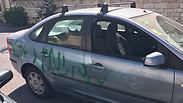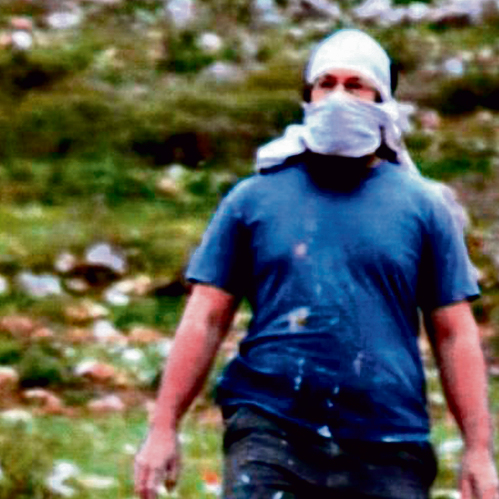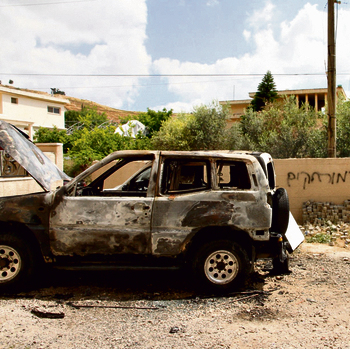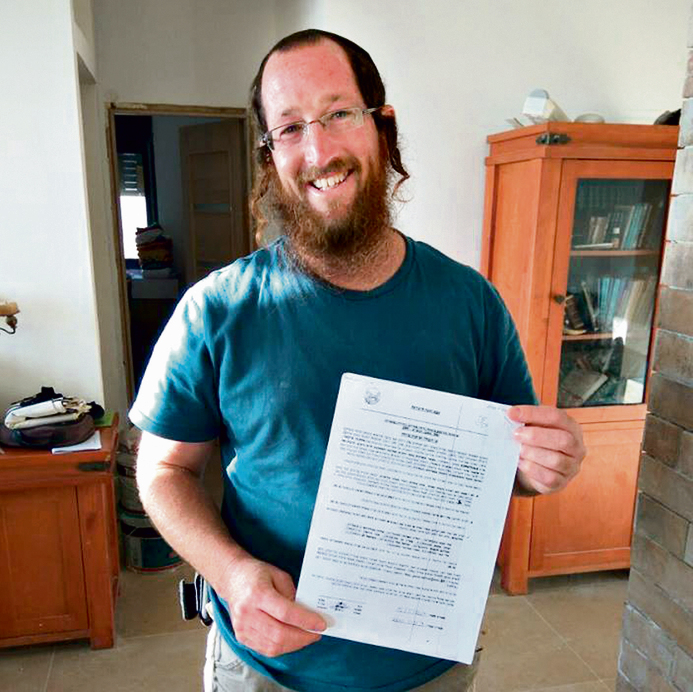
Jewish terrorism is rearing its head again
After two relatively quiet years, a collaboration between radical Yitzhar settlers and groups of teens living in outposts in the Binyamin region has led to the renewal of violent attacks against Palestinians, left-wing activists and members of the security forces. If the political echelon and settler leadership fail to act soon, Shin Bet officials warn, a second Duma murder is only a matter of time.
In the past two months alone, eight covert Jewish terrorist attacks have been recorded within the Green Line and in the Wes Bank: In Arab communities in Wadi Ara, in the northern village of Na’ura, in Jerusalem, and in Palestinian villages around the settlement of Yitzhar. So far, these attacks have involved vandalism of property, car torching and nationalistic graffiti on walls. There have been, in addition, multiple cases of Jewish rioting against soldiers, police forces, Palestinian residents and Israeli civilians, sometimes resulting in injuries.
In the past two years, they have been paralyzed, with almost zero attacks. Some of their leaders and perpetrators of attacks were sent to jail, while others were ordered to stay away from the West Bank. However, since the evacuation of the illegal outpost of Amona in February, the Jewish terrorists have been stepping up their activity. Shin Bet officials have pointed to escalation in Jewish terrorist activity similar to the previous wave, which reached its peak in July 2015 with the murder of the Dawabsheh family in the village of Duma.
The Shin Bet’s Jewish Division and police forces dealing with the Jewish nationalistic subversion are working at the same pace they did in 2015, which was a record year in the war on Jewish terror. But the “Duma effect,” which shocked Israeli society and gave the Shin Bet and the Israel Police the tools and support to strike this terror, has worn out since then.
In professional definitions, Jewish terrorism is now in its “third stage” in the degrees of escalation. The first stage is violence around the communities. The world view of Jewish terrorists is as follows: In our places of residence, there must not be a single ‘enemy’ in our line of vision—police officers, soldiers, Palestinians, or left-wing peace activists. No one. Whoever comes near will be targeted. If a Palestinian accidentally finds himself at the gate to Yitzhar, he has no chance of escaping unharmed. A Border Police jeep approaching the area will be pelted with stones.
The renewed Jewish terrorism has two centers of activity. The first one is Yitzhar, where the “price tag” acts of vandalism were invented and where the anti-Zionist perception has been fostered. The second one, which at the time was given the tender nickname “Hilltop Youth,” is made up of violent groups that live in the “Baladim” outposts in the Binyamin region, like Geulat Zion and Ramat Migron. Some of these outposts are located inside a closed military zone, but who cares? Some are removed occasionally, and nobody deals with the rest. It’s where the hard core of the “Revolt Group,” led by Rabbi Kahane’s grandson Meir Etinger, came from. Two members of this group were charged in the Dawabsheh murder, and the group was also behind the arson attack at Jerusalem’s Dormition Abbey and at the Church of the Multiplication of the Loaves and Fish on the shore of the Sea of Galilee.
The Yitzhar and Baladim delinquents have teamed up in recent months, and the hilltop youth are being led to terror activities by violent youth from the community.
In the second stage, the youths leave the community on “Shabbat trips,” as they are known in Yitzhar. After the morning prayer, they head to villages like Burin, Urif and Hawara, and beat residents up. In most cases, the IDF is aware of these processions in advance and soldiers are dispatched to the area, but are attacked as well. The Israel Police’s Judea and Samaria District has recorded 17 violent attacks in the past few months by residents of Yitzhar and the Baladim outposts against Arabs, soldiers and left-wing activists. All the attackers had a previous criminal record.
On April 22, during one of these “Shabbat trips,” Yitzhar youths carried out a violent raid in the villages of Urif and Hawara. Several Palestinians were injured, including an elderly woman. IDF forces were dispatched to the area, and an IDF officer was injured too. In one incident, an IDF officer fired his gun into the air after being angrily assaulted by the Hilltop Youth from the Baladim.
On April 21, some 15 masked Baladim youth attacked left-wing activists and Bedouin shepherds with stones and clubs and beat them up severely. Miraculously, only four people were injured in the incident. After taking all their anger out on the shepherds, the rioters stopped at the Kochav Hashachar community for a well-earned rest.
Kochav Hashachar is a normative settlement. Police Commissioner Roni Alsheikh even lived there in the past. The community’s residents, however, didn’t mind offering our good men shelter and support. Only after the police showed the community leaders a video documenting the near-lynch and the jokes exchanged by those Hilltop Youth members near the Kochav Hashachar grocery store, the community leaders broke off contact with them.
Support in the Knesset
The gradual disappearance of the Duma effect is reflected in the Kochav Hashachar incident. But these settlers are not alone. Some Knesset members have renewed their support fro these groups of rioters.
The connection between the Hilltop Youth and Yitzhar’s residents has a financial aspect too. The Hilltop Youth work as handymen for contractors in Yitzhar. They sleep over there and stay for Shabbat as well.
In mid-May, the national-religious press reported that Elkana Pickar, an Yitzhar resident, was slapped with a restraining order for two months over violent activity. The residents of Judea and Samaria were shocked by the “injustice” he suffered in the hands of the Shin Bet. Right-wing activists paint Pickar as a “social worker” who accommodated those Hilltop Youth in his home as an act of charity. The authorities’ version is slightly different: The youth stayed in his home, worked for him as handymen, and on Saturdays they would hike in the area, beating up Arabs, vandalizing property and, if the IDF showed up, handling the soldiers too. The Shin Bet requested a four-month restraining order against him, but the judge only approved two months.

Deputy Knesset Speaker Bezalel Smotrich (Bayit Yehudi) rushed to pay a visit to the Pickar family. Smotrich referred to the administrative order issued against the father as an act of “stupidity and insensitivity.”
“This father is the breadwinner of a family with six children,” he tweeted. “He is the only one has managed to get through to the Hilltop Youth and keep them in check a little. All the welfare people go through him. This is so-called democracy.” It seems that Smotrich and his ilk have not learned a thing.
The third stage of Jewish terrorism is the “covert stage”: Attacks carried out at night by small cells. Here’s a partial list from the last few weeks: In late March, a “price tag” operation was executed at the Spanish Consulate in Jerusalem; on April 26, a car was torched and nationalistic slogans were spray-painted in Hawara, near Yitzhar; on May 5, car tires were punctured and graffiti was discovered in east Jerusalem; on May 9, vehicles were vandalized in Shuafat; that same night, vehicles were vandalized and graffiti was spray-painted in the northern village of Na’ura, near Afula; on May 19, a tractor was torched and graffiti was spray-painted in the village of Burin, near Yitzhar; on May 24, cars were torched in the village of ‘Ara; on May 28, a car was vandalized and spray-painted with graffiti on Mount Zion in Jerusalem. And the list goes on.
The third stage is critical in the organization of a terror cell. This is when the members start using secret communication and plan their attacks in advance, as well as gain confidence.
This brings us to the fourth stage, which includes planned and intentional attacks on people, vandalism of Arabs’ homes and damage to mosques and churches. While Jewish terrorism has kept a low profile over the past two years, its goal and ideology have not changed: If the State of Israel is delaying the Messiah’s arrival, we’ll set the state on fire. We’ll spark disputes between Israel and the world’s nations, between Israel and the Palestinians, between the state and other religions, so as to bring about a civil war that would lead to the government’s collapse and the rise of a halachic state. Murder is seen as a legitimate means for bringing forth redemption.
Indeed, the murder of the Dawabsheh family in Duma was followed by a nine-month wave of terror. The murder of teenager Muhammed Abu Khdeir in July 2014 sparked riots among Israel’s Arabs and the Arab residents of Jerusalem, which lasted about six months. As far as Meir Etinger’s Revolt Group and its likes were concerned, it was a success.
These are pronounced anti-Zionist organizations. These people don’t join the IDF. On the contrary, they see Israeli law enforcement authorities and security forces as an enemy. In 2016, several Hilltop Youth members were accidentally drafted. While at the recruitment center, they managed to cause damage and spray-paint “price tag” graffiti. The army quickly got rid of them.
Naturally, they have their spiritual halachic leaders, like Rabbi Yitzhak Ginsburg, head of the Od Yosef Chai yeshiva in Yitzhar. They don’t always listen to him, nor do they listen to other rabbis who they allegedly find acceptable. They are not driven by settling the Land of Israel, nor by security motive or any political developments. They don’t care about US President Donald Trump. They want to destroy the Zionist state. All they need is the opportunity to do so.
Even today, there are public figures who support them. At least one of them, a Knesset member who has made no effort to conceal his sympathy towards them, is extremely familiar with the Shin Bet’s investigation rooms himself, after facing the security agency’s investigators about a decade ago on suspicion of being an accomplice in a planned terror attack. He sat there, remained silent and was released. In 2005, that was still possible.
Before 2014, not a single indictment had been filed against these rioters. The Duma murder was the turning point. As soon as “price tag” attacks were defined as acts of terror for all intents and purposes, the Shin Bet launched a thorough cleanup that led to two quiet years. The Yitzhar yeshiva—a hornet’s nest itself—was seized by security forces in April 2014. Its students were sent away and were only allowed to return in June 2015.
From late 2014 to 2017, there was a considerable decline in the activity of anarchistic groups in the West Bank. The two main groups—the Hilltop Youth and the Yitzhar youths—were either arrested or expelled under an administrative order. The Shin Bet used the “lawnmower” method, just like it did against Hamas. Its investigators found their way to anyone who had anything to do with Jewish terrorism and interrogated them.
Conspiracy of silence broken
According to figures presented by the Nationalistic Crime United in the Israel Police’s Judea and Samaria District, 600 right-wing extremists were arrested in 2014. The police and the Shin Bet didn’t let up the pressure in 2015 and 2016 either. More than 430 people were detained for questioning in each of these years. In the first four months of 2017 alone, 235 people were detained for questioning. Thanks to the changed policy, 116 indictments were filed in 2014, 90 were filed the following year, and 98 were filed in 2016 following the completion of investigations from previous years. Thirty indictments were filed in the first four months of 2017.
At least one thing has changed: The “conspiracy of silence” in the interrogation has been broken. Cases were solved, people were removed from the area or sent to prison. Last year was a record year in removing extremists under an administrative order, as 83 people were ordered to stay away from the area.
The disappearance of the operational ranks led to a pause in Jewish terrorism. In 2013, there were 607 violent acts of Jewish terrorism against Arabs. Hardly any incidents were recorded from late 2015 to early 2017, in spite of the knife intifada. There were only 162 incidents in 2016. The first quarter of 2017, however, recorded as many as 82 incidents. At this pace, the numbers are likely to double and triple themselves.
For two years, they were afraid and kept a low profile. In recent months, however, the first culprits captured in the wave of arrests that began in 2014 have been released from prison. The first to return home was Binyamin Richter of the illegal outpost of Havat Gilad, who was convicted in an arson attack in the village of Far’ata in late 2013. Richter symbolizes the return of former prisoners to their place of origin. Like on the Palestinian side, these former prisoners are leading figures in the renewed terror.
What has changed more than anything else is the atmosphere. The political echelon and the Yesha leaders have become accustomed to the calm. The sense that a solution had already been found for Jewish terrorism made all systems, including the judicial one, drop their guard. Today, the Shin Bet is having much more trouble getting restraining orders and administrative detention orders, and the rioters’ groups are no longer excluded in many Judea and Samaria communities.
By the way, it wasn’t the Duma murder that shook up the settler leadership. Public figures in the settlements and right-wing MKs argued at the time that the murder had been committed by Arabs. They broke off contact with the Hilltop Youth only after seeing a video that showed teens dancing in a wedding while stabbing a picture of infant Ali Dawabsheh. The Israeli public was shocked, and the settler leaders were concerned that it would harm the legitimacy of the settlement enterprise. Only then did they denounce these groups. But people have a short memory, time is a great healer, and Shin Bet officials are warning that without an immediate change in perception, the next wave of Jewish terrorism is just around the corner. A second Duma attack is only a matter of time.












